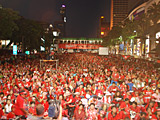Confrontations and Conspiracies in Thailand
By Simon Roughneen for ISN
On Thursday, the redshirts called off a rally scheduled to take place at one of Thailand's news stations, which they accuse of biased reporting. That came after a gunfight on a highway north of the city, close to the old international airport, when redshirts baited the government by attempting to send around 2,000 of their group to a market north of Bangkok.
After royalist yellowshirts had defied an emergency decree with impunity by holding several small rallies around Bangkok, urging the government to remove the redshirts now seven weeks into their mass rally in the heart of the city, it appears the redshirts sought to test the security force reaction by sending a convoy onto the northbound highway.
A predictable skirmish ensued, and 18 protesters were injured and one soldier killed amid a shoot-out on the highway close to the city's old international airport. It was the third serious incident of violence since the redshirt rally started over a week ago, following explosions that rocked the financial area of the city. On 10 April street fighting left 25 dead, after gunmen among the redshirts targeted an army officer closely connected to the country's royal family.
Since then, there have been almost daily threats to break the redshirt protest, but the government is still to act on those. The army head has pushed a cautious note, suggesting the stand-off be resolved politically. But after some success in negotiations last weekend, Prime Minister Abhisit Vejajiva pulled the plug on talks fronted by government point-man Sukhumbhand Paribatra, governor of Bangkok.
Pressure applied from the ostensibly pro-government yellowshirts - who have made themselves over into 'no colors' or 'multi-colored' protesters - seems to have pushed the government into playing its King of Hearts card. At a press conference last week, it alleged that the redshirt movement had a sinister, unspoken agenda: to undermine the country's monarchy.
When Thaksin Shinawatra was in power, he doubtless centralized power around himself, generating an incipient personality cult. Still, he remains the only Thai prime minister to win two elections on the bounce, something that rankles with the elitist yellowshirts and like-minded thinkers in the governing Democrat Party. To them, the redshirts are mindless peasants in the pay of Thaksin, unwitting foot soldiers in a battle led by a power-crazed, corrupt fugitive.
Social commentators, even including some at the anti-redshirt Nation newspaper, are starting to acknowledge that the redshirts are aware of their own socio-economic disadvantage and see political protest as a means to possibly address this.
Nobody knows for sure who was behind the explosions in Silom, the financial area of the city, last week. The government pulled back on its initial fingering of the redshirts, who denied responsibility. But on 10 April, gunmen whispered to be army rogues fired at soldiers sent in a clumsy attempt to break up the redshirt rally.
In previous weeks, redshirt leaders had spoken openly of civil war in Thailand if the government refused their demand to grant fresh elections and/or clamped down on their protest.
Both sides speak of 'third hand' agent provocateurs out to foment violence, which comes across as an attempt to distance themselves from the still-to-be-explained events of 10 and 22 April.
But going beyond the red versus yellow, red versus government face-off is a likely split between and within the security forces, between the army and police, and between pro and anti-redshirts in the military.
Mostly this plays out behind the scenes, but when there is a public dimension added, the impact is deadly.

